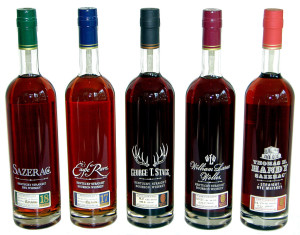Comparing The Buffalo Trace Antique Collections By Facts, Figures And Opinions
By Richard Thomas
While Pappy Van Winkle gets the attention in the mainstream press, among true die-hard bourbon enthusiasts the most anticipated annual whiskey release is arguably that of the Buffalo Trace Antique Collection (BTAC). While bourbon fans obsess about the technical details of other annual bourbon releases too, and the Van Winkles cost more, only BTAC brings together high prices and nerdy fixation with so much critical praise, and in a group of five whiskeys all released at the same time. That combination makes it the crowning set of American whiskey’s limited releases.
Yet despite the spotlight BTAC receives every year, one point gets very little discussion: how does the current crop measure up against its predecessors. Buffalo Trace itself frequently compares the proofs of its trio of cask strength releases (Stagg, Handy, Weller) against the past, and many bloggers make casual observations, but to date there has been no serious and systematic comparison of the various BTAC batches.
The Whiskey Reviewer has been compiling notes on BTAC since 2012, and while this is only a slice of BTAC’s now decade and a half history, it does provide a good look at the releases during the course of the modern “bourbon boom.”
Eagle Rare 17 Year Old: This year marks a departure for this popular, and most easy drinking, part of the Antique Collection. The aged version of Eagle Rare was one of two whiskeys that, upon reaching a mature sweet spot, were dumped into stainless steel tanks for long term storage, but last year’s installment was the last to draw on the “classic” Eagle Rare 17 Year Old stock.
“New” Eagle Rare 17 Year Old shares many stats (mashbill, barrel-fill proof, barrel char, etc.) with the old stock, but was aged in a different set of warehouses. That (and perhaps global warming) helps account for the one thing that stands out in the stats, namely a loss to evaporation that is a dozen points higher than was the case with the “classic” Eagle Rare stock, 66% to 54%. In short, if there is a clear difference on paper it is that this stuff got “cooked” more.
But how about in the bottle? Based on this year’s review, drinkers should find new Eagle Rare 17 is as good or slightly better than old Eagle Rare 17.
George T. Stagg: The stats tell us that this year’s Stagg is the youngest in recent memory (15 years old compared to 16 or 17), but at 138.2 proof this uncut, cask strength release sits right in the middle of its range. Yet if this current Stagg is younger, the numbers make it clear why they had to pull it out of the warehouses: the evaporation rate was a staggering 84%, roughly 10 points higher than has been the case in recent years. Like the current Eagle Rare 17, George T. Stagg 2015 was one thoroughly cooked whiskey.
That extremely high loss to the angel’s will make this year’s George T. Stagg the rarest installment yet. When word about it gets out, it ought to become the dearest as well. The Whiskey Reviewer is declaring it to not only be the best whiskey in the 2015 BTAC set, but the best expression of Stagg in recent memory.
Sazerac 18 Year Old: Just as Eagle Rare 17 Year Old made a transition to a new base of stock this year, so Sazerac 18 Year Old will be making that transition next year. The 2015 Sazerac 18 is the last batch to come out of the stainless steel tanks. Thus, the answer to how it compares to past installments is very similar, if not the same.
Thomas H. Handy: The high octane Handy Rye doesn’t come from stainless steel tanks, but it represents a very stable picture in terms of its stats. Year after year, only the warehouse the whiskey was aged in varies. Age, evaporation rate, barrel char, mashbill, filling proof, and dumping proof all vary but little.
In recent memory, only the 2012 Thomas H. Handy came in as an oddball, that one with a proof of 132.4, a few points higher than the norm. That Handy Rye was also scored the best ever, but this year’s installment was a close second, making the 2015 Thomas H. Handy something rye whiskey aficionados should be scrambling to get.
William Larue Weller: The BTAC “wheater” bourbon is now the most expensive of the lot, and is (like Handy) very similar year to year. The BTAC Weller is an uncut, unfiltered 12 year old bourbon, but the last two years have seen a soaring evaporation rate. The 2015 William Larue Weller saw the highest in recent memory, 72%, which is 10 points higher than last year’s. This, in turn, was several points higher than had been the norm in the years previous. The idea of “thoroughly cooked” whiskey has become a theme with this year’s BTAC.
That extra hot cooking seems to have done Weller some good, as the 2015 Weller seems to have surpassed the 2014. Yet in the opinion of this publication (and many others), the best in recent memory was the 2012 William Larue Weller.
 The Whiskey Reviewer A World of Whiskey, Poured Every Weekday
The Whiskey Reviewer A World of Whiskey, Poured Every Weekday


So new Eagle Rare 17, last of the Sazerac 18, good Weller and Handy, and a stand-out Stagg? Sounds like cause to collect the whole set, if you have a couple of grand laying around.